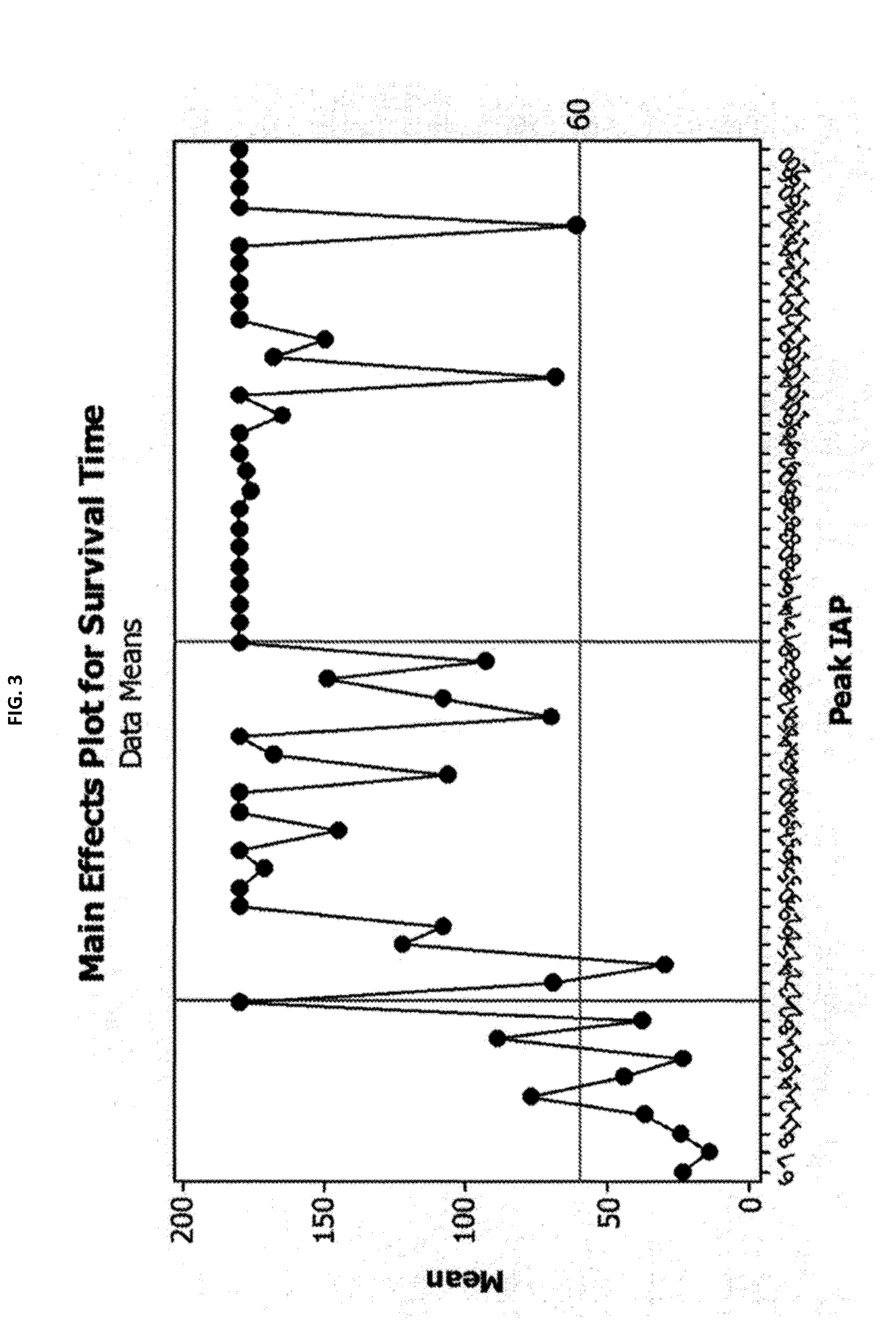Intra-abdominal pressure to promote hemostasis and survival
- Summary
- Abstract
- Description
- Claims
- Application Information
AI Technical Summary
Benefits of technology
Problems solved by technology
Method used
Image
Examples
example 1
Dose-Dependent Changes in Spike and Steady-State Pressure Values and Survival in a Hepatic Hemorrhage Model
[0031]In situ forming foams were delivered in the grade V hepatic-portal model described above. Animals were given 64 ml, 85 ml, 100 ml or 120 ml of liquid-phase in situ forming foam formulations, or sham treatment in the case of control animals, and IAP was measured over an interval of 3 hours. As shown in FIG. 1, control animals showed only a minor increase in IAP over the first 20 minutes of the experiment, while foam-treated animals displayed dose-dependent changes in spike pressures and steady-state pressures. In addition, survival was quantitated for animals in each treatment category.
[0032]Foam dosages in the swine models used herein are likely to be larger than the volumes used in humans, owing to differences in the volume of the abdominal cavity.
[0033]The control group was lethal in 11 of 12 animals (8.3% survival), with a median survival time of 23 minutes (quartile 2...
example 2
Dose-Dependent Changes in Spike and Steady-State Pressure Values and Survival in an Arterial Hemorrhage Model
[0036]Similar experiments were conducted in the arterial hemorrhage model described above. As shown in FIGS. 5 and 6, dose dependent effects on IAP and survival were observed in this model as well. There was a noticeable increase in percent survival at 1 hour for the 120 ml and 100 ml test groups relative to the control group (84% and 82%, respectively, vs. 14%; p<0.001). Hemorrhage rate at the experimental endpoint was significantly lower in both foam groups relative to the control.
[0037]By way of summary of the foregoing examples, Table 4 below depicts six exemplary experiments in which varying quantities of an in situ foaming formulation was administered to porcine in a liver hemorrhage and an iliac hemorrhage model.
TABLE 4TRANSIENT PEAK AND STEADY STATE PRESSURESOBSERVED IN VARIOUS EXPERIMENTS.LiverIliac ArteryHemorrhage ModelHemorrhage ModelPeakSteady StatePeakSteady Sta...
example 3
Approximation of Survival Effects by Gas Insufflation with Foam-Like Pressure Kinetics
[0039]While not wishing to be bound to any theory, it is believed that the foams disclosed above and used in the previous examples generated pressure spikes by one or more of a rapid increase in the volume of the foam, gas generated from the blowing reaction, gas generated and not fully contained by the foam, etc. The reduction in pressure to the steady state values, in turn, may have been due to one or more of a viscoelastic response of the tissues in the abdominal cavity, a change in fundamental abdominal volume, possibly caused by the relaxation of tissues in the abdomen, a reduction in the volume of the foam, gas transfer, etc.
[0040]In the models examined, larger doses of foam were associated with larger peak pressures, as shown in FIG. 1, and with improved survival, as shown in FIG. 2. To examine the relationship between the survival effect and the IAP profiles achieved, controls and animals t...
PUM
 Login to View More
Login to View More Abstract
Description
Claims
Application Information
 Login to View More
Login to View More - R&D
- Intellectual Property
- Life Sciences
- Materials
- Tech Scout
- Unparalleled Data Quality
- Higher Quality Content
- 60% Fewer Hallucinations
Browse by: Latest US Patents, China's latest patents, Technical Efficacy Thesaurus, Application Domain, Technology Topic, Popular Technical Reports.
© 2025 PatSnap. All rights reserved.Legal|Privacy policy|Modern Slavery Act Transparency Statement|Sitemap|About US| Contact US: help@patsnap.com



